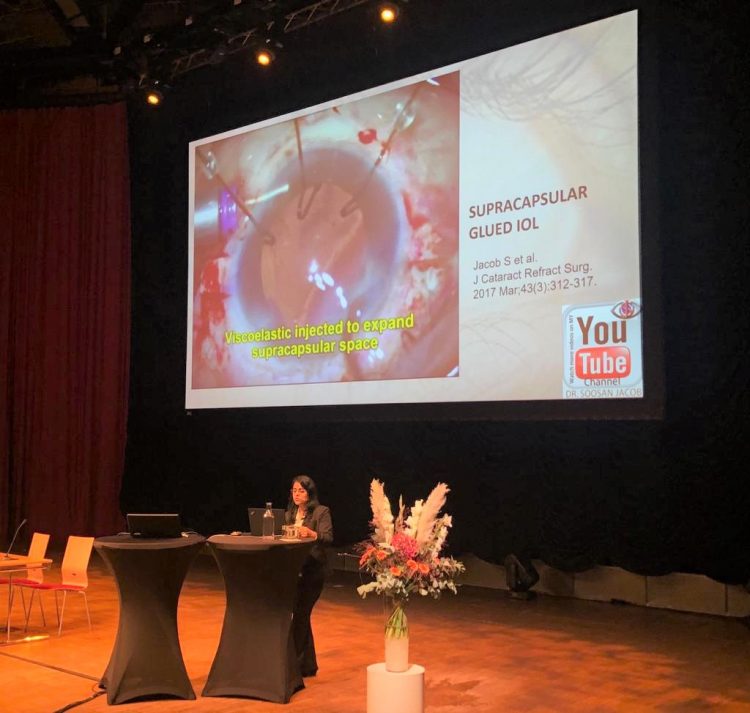Swedish Society Meeting
In an interview with Dr Soosan Jacob, Prof. Madeleine Zetterberg, Scientific Secretary, Swedish Ophthalmological Society describes key contents of the society's annual meeting.

Soosan Jacob
Published: Wednesday, October 23, 2019
 Dr Soosan Jacob addressing delegates at the Swedish Ophthalmologic Society Meeting
Raymond Douglas, Cedars-Sinai Medical Center, Los Angeles, an authority in orbital, oculoplastic and reconstructive surgery spoke on ground-breaking research that lead to the development of IGF1-receptor antagonist therapy against thyroid eye disease.
Soosan Jacob gave a keynote lecture on complex reconstructions combining various anterior segment surgeries. She also spoke on her innovations such as PEARL Inlay for Presbyopia, CAIRS for keratoconus and Paper clip capsule stabilizer for subluxated cataracts.
The session devoted to retinopathy of prematurity (ROP) was a highlight. Andreas Stahl, University Medical Center, Greifswald talked about the CARE-ROP study, a randomized multi-centre study investigating optimal dosing of Ranibizumab in ROP. He shared his experience as member, steering-committee in several renowned ROP-studies such as PRIDE- and RAINBOW-studies and as initiator of German national ROP-register.
Gerd Holmström, Uppsala Hospital, Sweden, demonstrated the importance of national patient registries, in this case SWEDROP, where 10-years outcome (n=10000) resulted in improved outcomes and decreased screening visits.
Aldina Pivodic, Sahlgrenska Academy, Gothenburg, reported an individualized prediction model (freely available at www.digirop.com) for developing sight threatening ROP with 100% sensitivity and high specificity developed using SWEDROP data (n=7900).
Lotta Gränse, Lund University Hospital demonstrated the impact of using Retcam images for screening and during laser treatment (performed close to the ridge and only two disc diameters wide) to minimize ROP recurrence.
Ann Hellström, Queen Silvia Children’s Hospital, Gothenburg discussed risk factors and preventive measures for ROP, highlighting the importance of personalized oxygenation, nutritional components such as breast milk, Omega-3 and Omega-6 fatty acids as well as effect of fetal blood components such as fetal hemoglobin, growth factors and hematopoetic stem cells on ROP.
Other topics discussed included TB-uveitis, minimal invasive glaucoma surgery (MIGS), orbital tumours, thyroid eye disease, corneal surgery etc.
An honorary lecture by Kristina Tornqvist about changes in care for the visually disabled over the last 100 years and the annual SOE lecture for the most accomplished clinician/ researcher with a promising future was delivered this year by David Epstein from St Erik’s Eye Hospital / Karolinska Institute were other highlights.
Dr Soosan Jacob addressing delegates at the Swedish Ophthalmologic Society Meeting
Raymond Douglas, Cedars-Sinai Medical Center, Los Angeles, an authority in orbital, oculoplastic and reconstructive surgery spoke on ground-breaking research that lead to the development of IGF1-receptor antagonist therapy against thyroid eye disease.
Soosan Jacob gave a keynote lecture on complex reconstructions combining various anterior segment surgeries. She also spoke on her innovations such as PEARL Inlay for Presbyopia, CAIRS for keratoconus and Paper clip capsule stabilizer for subluxated cataracts.
The session devoted to retinopathy of prematurity (ROP) was a highlight. Andreas Stahl, University Medical Center, Greifswald talked about the CARE-ROP study, a randomized multi-centre study investigating optimal dosing of Ranibizumab in ROP. He shared his experience as member, steering-committee in several renowned ROP-studies such as PRIDE- and RAINBOW-studies and as initiator of German national ROP-register.
Gerd Holmström, Uppsala Hospital, Sweden, demonstrated the importance of national patient registries, in this case SWEDROP, where 10-years outcome (n=10000) resulted in improved outcomes and decreased screening visits.
Aldina Pivodic, Sahlgrenska Academy, Gothenburg, reported an individualized prediction model (freely available at www.digirop.com) for developing sight threatening ROP with 100% sensitivity and high specificity developed using SWEDROP data (n=7900).
Lotta Gränse, Lund University Hospital demonstrated the impact of using Retcam images for screening and during laser treatment (performed close to the ridge and only two disc diameters wide) to minimize ROP recurrence.
Ann Hellström, Queen Silvia Children’s Hospital, Gothenburg discussed risk factors and preventive measures for ROP, highlighting the importance of personalized oxygenation, nutritional components such as breast milk, Omega-3 and Omega-6 fatty acids as well as effect of fetal blood components such as fetal hemoglobin, growth factors and hematopoetic stem cells on ROP.
Other topics discussed included TB-uveitis, minimal invasive glaucoma surgery (MIGS), orbital tumours, thyroid eye disease, corneal surgery etc.
An honorary lecture by Kristina Tornqvist about changes in care for the visually disabled over the last 100 years and the annual SOE lecture for the most accomplished clinician/ researcher with a promising future was delivered this year by David Epstein from St Erik’s Eye Hospital / Karolinska Institute were other highlights.